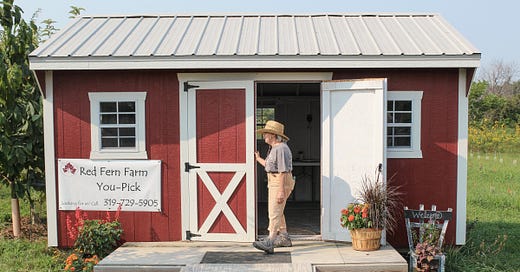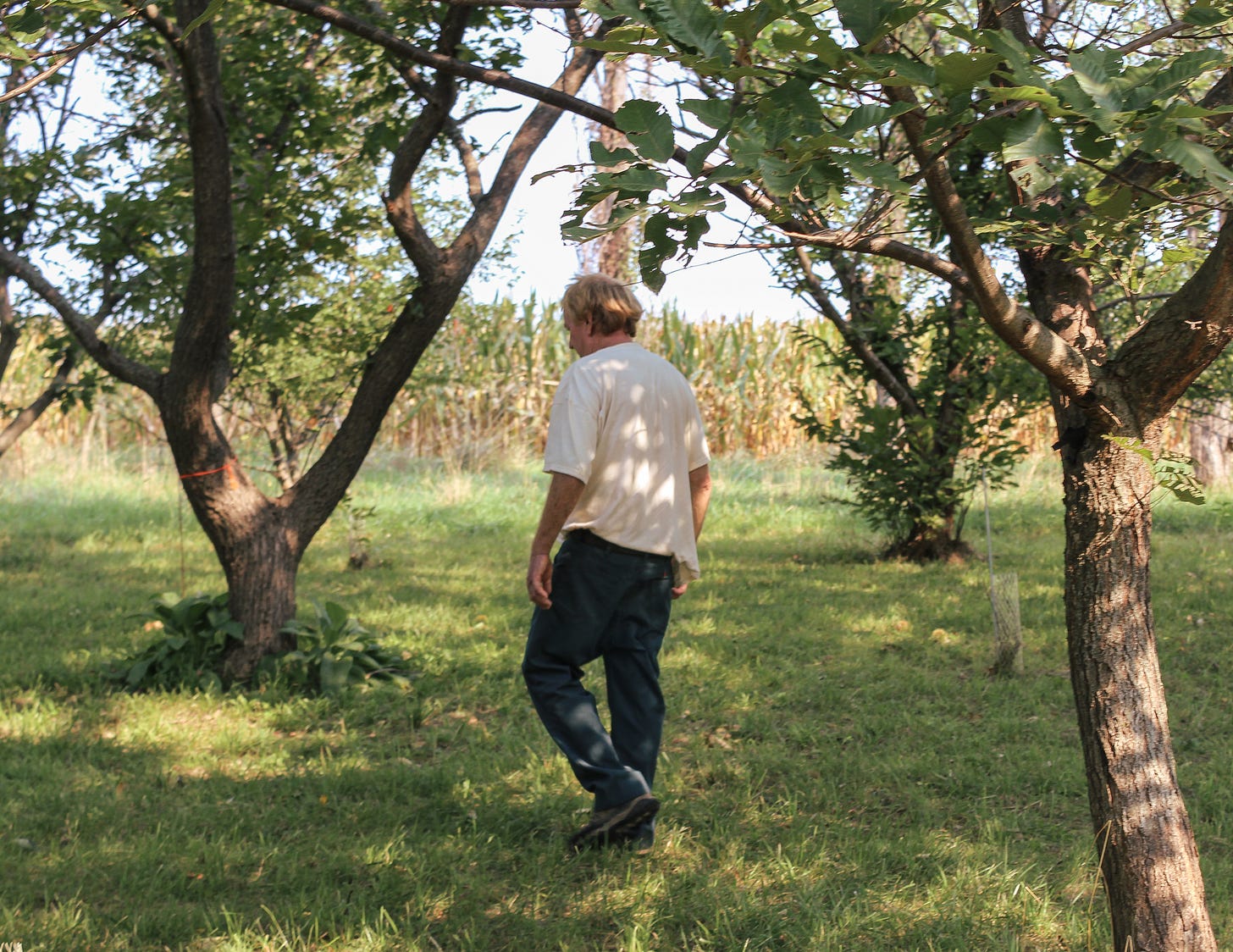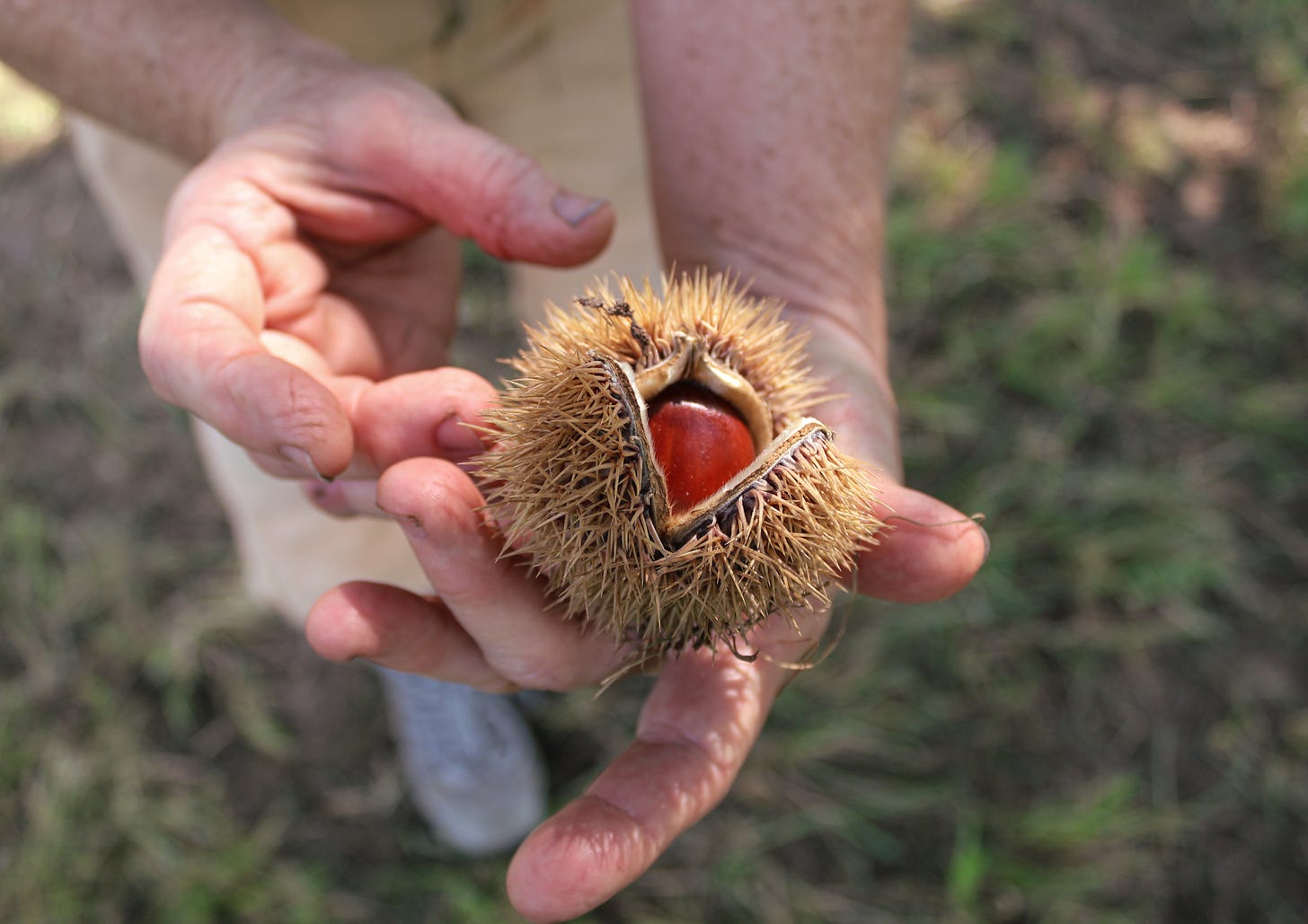Poets and farmers working together to preserve the land? How does that work? Take a look at a fascinating new anthology called Writing the Land: Foodways and Social Justice, edited by Lis McLoughlin, NatureCulture Press. Inside the book, you’ll find poets across the country responding to the work of conservation-minded farmers involved in land trusts, non-profit organizations safe-guarding the countryside for natural areas and human food production.
In this project, I was paired with Red Fern Farm near Wapello, Iowa, owned by Tom Wahl and Kathy Dice. The couple, both with degrees in Fish and Wildlife from Iowa State University and members of SILT (Sustainable Iowa Land Trust), did a deep dive into the ecological and social history of their property, transforming their row crop acres into a perennial paradise of fruit and nut trees.
Agro-forestry by-passes the usual agricultural problems of tilling, soil erosion, and use of chemicals. In an era when Iowa imports 90 percent of its human food, Red Fern Farm offers the public native fruits and nuts, the trees holding the soil in place, thriving in their natural habitat free of expensive and toxic inputs.
Last fall, I interviewed Kathy and Tom, spending several days on their farm, then I sat on my own back porch one week-end, writing this poem. I also posted two podcasts about the trip.
Red Fern Farm
1.
Corn is not the answer.
Then what is?
Chestnuts planted into the rich soil
at Red Fern Farm, just two miles
from where the Mississippi River flows,
where the paleo people lived 10,00 years ago,
mammoth hunters whose points you’ve held in your hands.
Then the archaic people struggled
with droughts and dry prairie, giving way
to the mound builders and the Oneotos,
living in pine forests along rivers and streams,
the last prehistoric culture, giving way
to the Ioway, Meskwaki, Sac and Fox,
Ho-Chunk, Black Hawk, and Sioux.
All who broke very little ground,
who kept no livestock,
who kept the earth in place
in a place where the sky was black
with migrating pelicans, ducks, and geese,
diving down to fish in the wetlands
with the turtles, frogs and snakes looking on.
It’s for the birds’ sake, for the sake of all
who’ve preserved this land,
for the sake of the native people,
the native prairie, the sake of all
the settlers and sons and daughters
of the homesteaders trying to claim
a home, trying to make a buck
on “free land,” land parceled out
to anyone who could stick it out five years.
For the sake of the sons and daughters
of the sons and daughters who stayed
for generations, pushed
to expand, to do as they were told
with tillage, chemicals and yields,
trying to get big before they had to get out.
But you wouldn’t be told.
And the chestnuts began to grow.
2.
And so did the heartnuts, hazelnuts, honey and
aronia berries, Asian pears, cornelian cherries,
and hardy kiwi vining up the sides of trees.
And so did the persimmons,
sweet, mild, rich and picked
in the early fall, the days still warm,
the fruit still hard, ripening off the branches,
tasting like an apricot-- maybe even better--
smelling like sweetened dough
with a dash of cinnamon.
Too soft to slice, simply cut in half,
the flesh scooped out for a smoothie,
a compote, a dried treat, a pudding
or upside-down cake with the pulp mixed
with flour, baking soda, nutmeg,
cloves, chopped pecans and lemon zest.
What, no Delicious apples? No Bartlett pears?
No, nothing to be pruned.
No vegetables? No broccoli, tomatoes, sweet corn?
No, nothing to be dug up, turned over.
Only asparagus or horseradish that comes up
all on its own from year to year.
And for the future?
No annual crops.
An easement in place, protecting the farm
from the bulldozer, lapsing back into row crops,
the speculator with a housing development
or a theme park with flashing neon signs
and rides and slides shooting
screaming teens into an artificial lake.
Only perennials: drowning in trees, bushes, shrubs
that will grow well in this changing climate zone.
Who knows what the future will bring?
Thirty years from now, the persimmon
may find the weather too tough.
“Now, that’s pretty extreme,” the land trust had said.
“Yes, yes, that’s extreme.” You said.
“We are extremists.”
3.
The paw-paws, too, are extremists,
extreme in their beauty, the maroon flowers
drooping down, producing a massive amount
of fruit on a single stem, the green bounty quietly
camouflaged, understated, hidden beneath its leaves,
the Quakers of the farm--like you, their owners--
mild in manner, mild in taste,
custardy like a banana crossed with mango.
Unlike apples, peaches, and pears,
the paw-paws never crossed the ocean.
A native tree familiar to the Meskwaki,
the Sac and Fox, the Ho-Chunk and Sioux.
A lucky find, a food source for the settlers.
But good for only two days,
paw-paws never hit the road,
never shipped across the country.
No one ever picked them
and put them in their pocket for long.
So the apples, peaches, pears pushed them aside,
and the paw-paws went way down yonder.
Yet here on Red Fern Farm, next to the chestnuts
and persimmons, the paw-paws bear witness,
greet Bosnians who crossed the ocean,
fleeing war, recreating their old world
custom of picking nuts in the fall.
The Bosnians pull into the U-Pick farm
in their vans with buckets and baskets.
Their vehicles fill with just a little
of what they left behind.
The nut wizard whirls across the ground
beneath our feet, in this ever-shifting place,
tree roots sinking in, communicating
through an intricate web of fungi
growing around and inside them,
telling the dirt to stay put,
stopping it from washing down river,
from carrying harm,
finding no one, nothing displaced.









Beautiful poem and such a hopeful vision!
So beautiful and evocative. Thank you for this lovely piece.